Why Understanding Refrigerators Matters in Modern Life
Is a refrigerator just a simple appliance that keeps food cold? While its primary job is preserving food by maintaining temperatures between 32-40°F (0-4°C), a refrigerator is actually a sophisticated heat transfer system essential to modern food safety and daily convenience.
Quick Answer:
- Definition: A refrigerator is an insulated appliance that uses a heat pump to transfer heat from inside to outside, keeping food fresh
- Temperature Range: Operates between 32-40°F (0-4°C) to slow bacterial growth
- Key Function: Preserves food by creating an environment that inhibits harmful bacteria reproduction
- Types: Includes household units, commercial walk-ins, reach-ins, and specialty cooling systems
The average American household depends on refrigeration for food safety, with 99.5% of U.S. homes owning at least one unit. Beyond convenience, proper refrigeration prevents foodborne illness and reduces waste.
From funeral homes requiring specialized mortuary cooling to restaurants needing walk-in units, understanding refrigeration basics helps you make informed decisions about capacity, efficiency, and maintenance.
I'm Mortuary Cooler, a national-level mortuary cooler supplier with experience in commercial refrigeration systems. My background in specialized cooling applications gives me unique insight into how is a refrigerator question applies across residential and commercial settings.
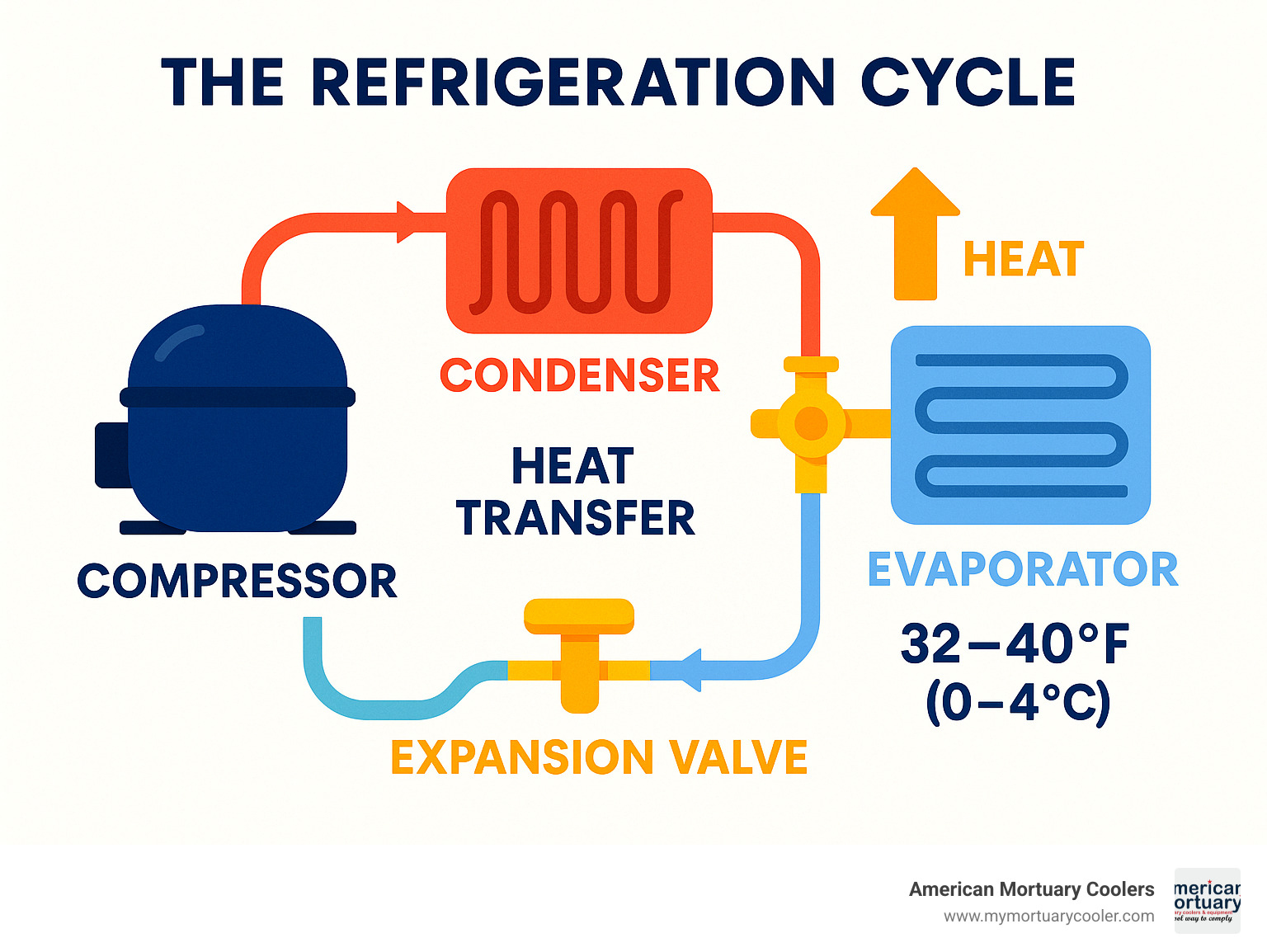
Is a refrigerator terms to know:
What Is a Refrigerator?
Is a refrigerator really just a box that keeps things cold? At its heart, a refrigerator is a cooling appliance that works like a heat pump in reverse, constantly moving heat from inside the box to outside your kitchen.
The magic happens in that sweet spot between 32-40°F (0-4°C). This temperature range slows bacterial growth without freezing your fresh produce. Unlike a simple cooler, your refrigerator actively fights against physics by forcing heat to flow from cool to warm areas.
Modern refrigerators come packed with smart technology, energy-efficient inverter compressors, and sophisticated temperature controls. Some can even text you when you're low on milk or let you peek inside while grocery shopping.
Here's how refrigerators compare to freezers:
| Aspect | Refrigerator | Freezer |
|---|---|---|
| Temperature Range | 0-4°C (32-40°F) | -18°C to -26°C (0°F to -15°F) |
| Primary Function | Slow bacterial growth | Halt bacterial growth completely |
| Food Storage Duration | Days to weeks | Months to years |
| Energy Consumption | Higher (opened more frequently) | Lower (opened less often) |
Historical Evolution: From Icehouses to Smart Fridges
Before modern refrigeration, people relied on the ice trade - cutting massive blocks from frozen lakes and shipping them worldwide. The breakthrough came in 1834 when Jacob Perkins patented the first vapor-compression refrigeration system, though it took until 1913 for the first practical electric home refrigerator.
The 1930s brought Freon refrigerants, making home refrigerators much safer. By the 1940s, frozen foods became everyday items instead of special treats. Today's ENERGY STAR programs and smart IoT refrigerators represent the latest evolution in this cooling technology.
So, Is a Refrigerator the Same as a Fridge?
Is a refrigerator the same as a fridge? Yes - "fridge" is simply the nickname for "refrigerator." Most Americans use the terms interchangeably. Regional usage varies, with some areas preferring the formal "refrigerator" while others accept the casual "fridge." There's no right or wrong choice.
How a Refrigerator Works – Components & Cooling Cycle
Ever wondered what makes is a refrigerator actually work? The secret lies in a clever cycle that moves heat from inside your fridge to the outside world through four key stages that repeat continuously.
First, evaporation occurs when liquid refrigerant absorbs heat from inside your fridge and turns into gas. Next comes compression, where that gas gets squeezed under high pressure. Then condensation happens as the hot gas releases heat and turns back into liquid. Finally, expansion occurs when the high-pressure liquid drops pressure and temperature dramatically.
For detailed information about these fundamentals, check out our Refrigeration System 101 guide and A Quick Start Guide to How Compressors Work in a Refrigerator. You can also explore Scientific research on refrigerant basics for deeper technical insights.
Key Components Under the Hood
The compressor truly earns its nickname as "the heart" of the system. This motor-driven pump squeezes refrigerant gas and pushes it through the entire system. Modern units use smart inverter compressors that adjust speed based on cooling demand.
The condenser acts like your car's radiator, releasing heat from compressed gas. You'll find these coils on the back or bottom of your refrigerator, where they cool the hot refrigerant and turn it back into liquid.
The evaporator works as the "cold plate" inside your refrigerator compartment. Here, liquid refrigerant absorbs heat from your food and turns into gas, creating the cold temperatures that keep food fresh.
The capillary tube creates a crucial pressure drop, ensuring refrigerant enters the evaporator at the right pressure and temperature. Modern defrost systems automatically prevent ice buildup that would reduce efficiency.
The Magic of Phase Change
The real genius behind refrigeration lies in latent heat - the energy needed to change refrigerant from liquid to gas without changing temperature. When refrigerant evaporates, it absorbs tremendous heat energy from your food.
Today's refrigerators use inverter technology to adjust speed based on temperature sensors, creating stable temperatures while using less electricity. The pressure differential throughout the system drives this entire process naturally.
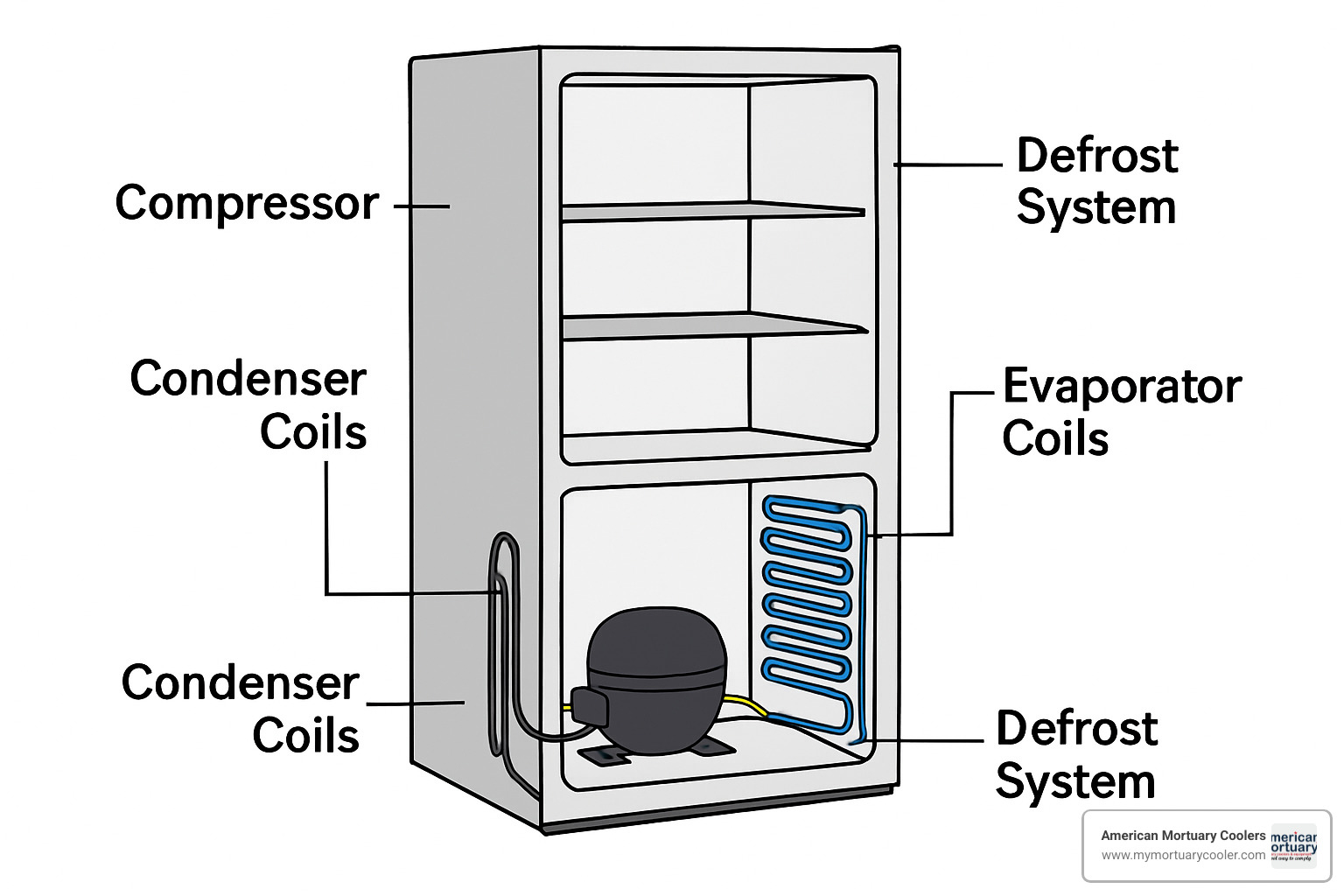
Types & Styles of Modern Refrigerators
Is a refrigerator limited to one basic design? Today's market offers amazing variety, each solving different problems and fitting different lifestyles.
Top-freezer refrigerators are the trusty workhorses offering the most bang for your buck with excellent reliability. Bottom-freezer refrigerators put daily essentials at eye level, perfect if you access fresh food more than frozen items.
French door refrigerators combine bottom freezers with double doors on top, providing excellent organization and energy savings since you only open one side at a time. Side-by-side refrigerators split everything down the middle, fantastic for narrow kitchens since nothing requires bending.
Counter-depth refrigerators create that sleek, built-in look without the built-in price tag, though you'll sacrifice some storage space. True built-in refrigerators disappear completely into cabinetry but expect premium pricing.
Mini fridges work perfectly for dorm rooms and offices, while commercial operations need walk-in coolers or reach-in units for serious storage capacity.
For specialized applications, check out our guides on Everything You Need to Know About Reach-In Refrigerators and Everything You Need to Know About Walk-In Refrigeration Units.
Pros & Cons by Configuration
Top-freezer models win the reliability contest with the lowest repair rates and most affordable pricing. Bottom-freezer units offer convenience by keeping fresh foods accessible but cost more upfront.
French door refrigerators provide premium features and great organization but typically have higher repair rates due to complex mechanisms. Side-by-side models excel in narrow spaces but consume more energy and limit space for wide items.
The key is matching style to your actual needs - a young couple might love a sleek French door model, while a large family might prefer a reliable top-freezer unit with maximum storage.
Specialty & Commercial Applications
Beyond household use, refrigeration serves specialized needs. Beverage coolers maintain perfect drink temperatures, medical refrigerators keep vaccines at precise temperatures with alarm systems.
At American Mortuary Coolers, we specialize in custom cooling solutions for funeral homes. Our mortuary coolers provide exact temperature control with reliable performance when it matters most, serving customers across Tennessee, Georgia, Illinois, South Carolina, Texas, California, New York, and Pennsylvania.
Buying Guide: Size, Capacity, Features & Efficiency
Shopping for a refrigerator becomes easier once you understand key principles. Is a refrigerator purchase something to rush? Definitely not - taking time to evaluate needs saves money and frustration.
The classic rule suggests 19-22 cubic feet for a family of four, but your lifestyle matters more than headcount. Weekly versus monthly shopping, entertaining habits, and cooking style all influence capacity needs.
That advertised capacity includes every interior inch, even areas blocked by components. Actual usable storage is typically 20-25% less than claimed capacity.
Counter-depth versus standard-depth units present interesting trade-offs. Counter-depth models create sleek, built-in appearance but sacrifice 2-4 cubic feet compared to standard-depth units that protrude further.
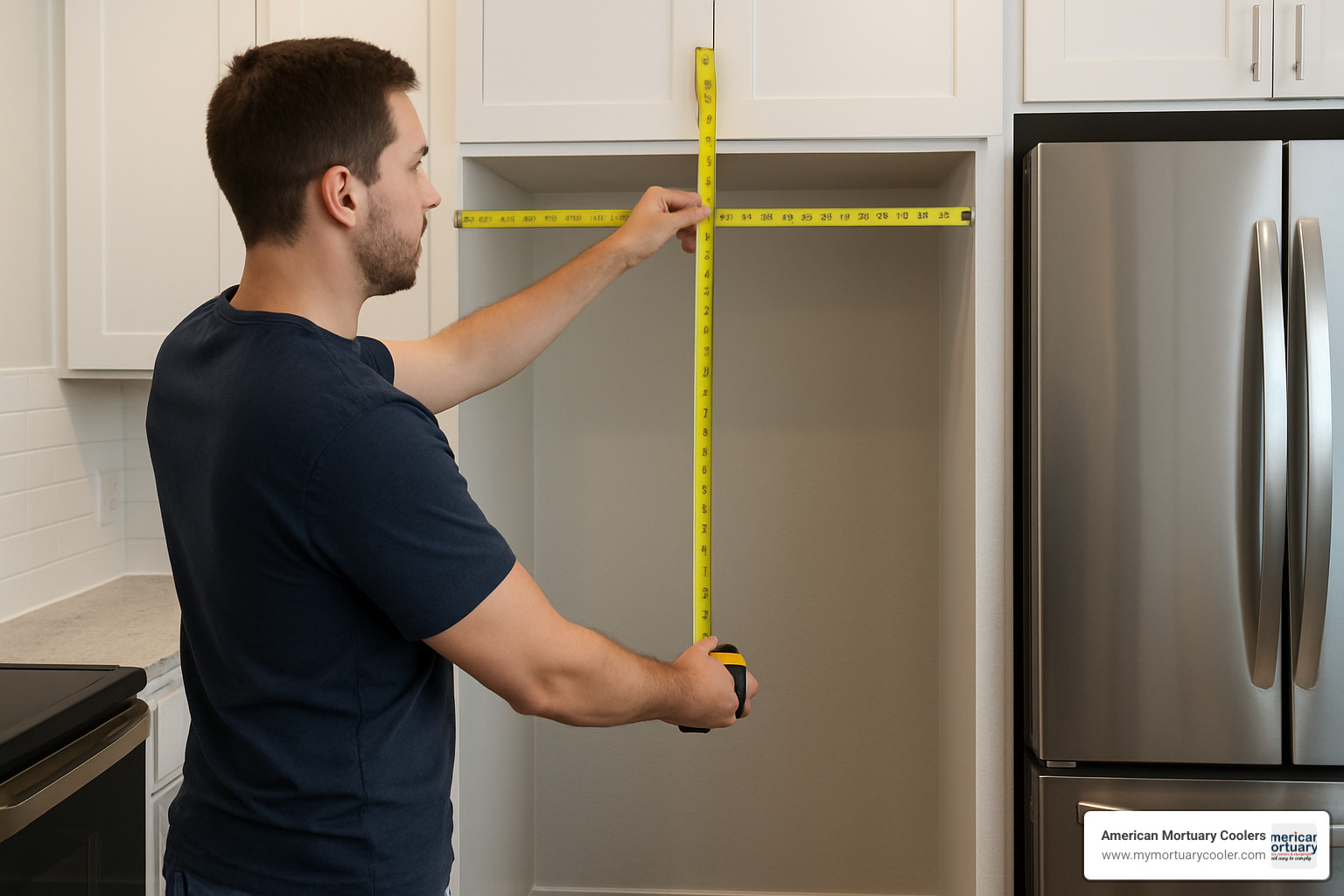
Energy efficiency deserves attention since refrigerators run 24/7 for 10-15 years. ENERGY STAR models use up to 50% less energy, potentially saving $50-60 annually. Modern inverter compressors adjust speed based on demand, like cruise control for your refrigerator.
Smart features add convenience but focus on core performance first. Wi-Fi connectivity, internal cameras, and voice control are nice but secondary to reliable cooling.
Shopping strategy matters - holiday weekends offer best deals, and many retailers price-match. Measure carefully and plan delivery paths through doorways and tight corners.
For temperature guidance, check our The Ultimate Guide to How Cold It Is in a Fridge and Scientific research on safe food storage.
Choosing the Right Capacity
Is a refrigerator size just about family headcount? Consider meal prep habits - batch cooking requires extra space. Bulk shopping needs significantly more capacity than daily fresh market visits. Seasonal considerations matter for garden produce and holiday entertaining.
Interestingly, bigger isn't always better. Oversized refrigerators consume more energy and encourage waste, while undersized units force frequent shopping and may struggle with temperature when overpacked.
Reading Energy Labels & Saving on Bills
The yellow EnergyGuide label shows annual energy consumption (kWh/year) and estimated yearly operating cost. Energy-saving features like LED lighting and improved insulation make real differences.
Many utilities offer rebate programs for ENERGY STAR appliances, sometimes $50-100 cash back. The math is compelling - efficient models cost more upfront but save $300-500 over their lifetime.
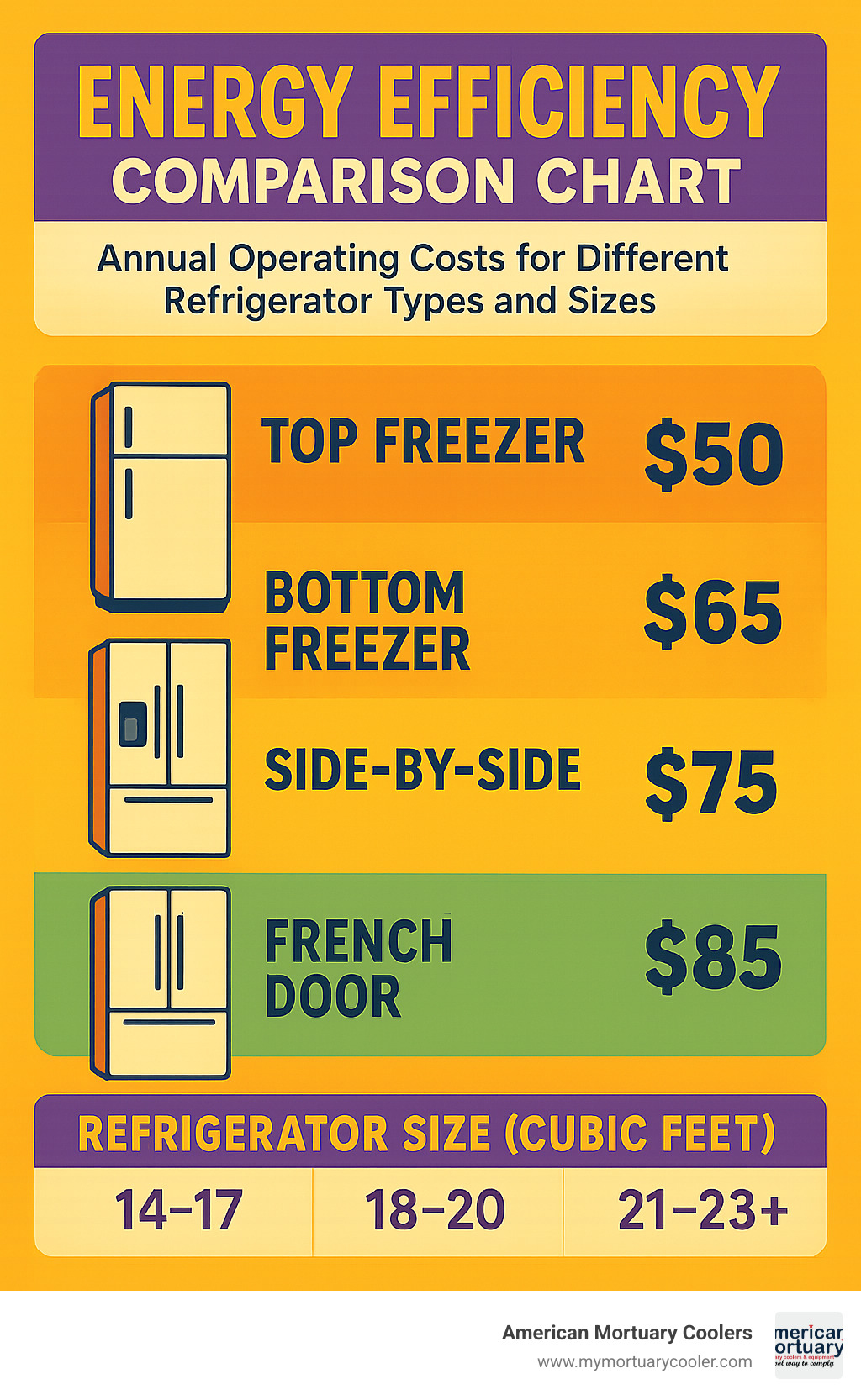
Maintenance, Safety & Smart Upgrades
Keeping your refrigerator running smoothly makes a real difference. Is a refrigerator maintenance like caring for your car? Absolutely - a little attention prevents expensive problems.
The average refrigerator lasts about 13 years, but proper care can extend that significantly while reducing energy use and repair needs.
Cleaning condenser coils every six months is crucial - dust buildup makes the compressor work overtime. Door gaskets deserve attention too. Test them by closing the door on a dollar bill - if it slides out easily, seals need replacing.
Temperature monitoring ensures your fridge maintains 32-40°F (0-4°C) for the refrigerator section and 0°F (-18°C) for the freezer. An inexpensive thermometer removes guesswork.
For comprehensive guidance, check our Refrigeration Preventive Maintenance Tips and More info about refrigeration units maintenance.
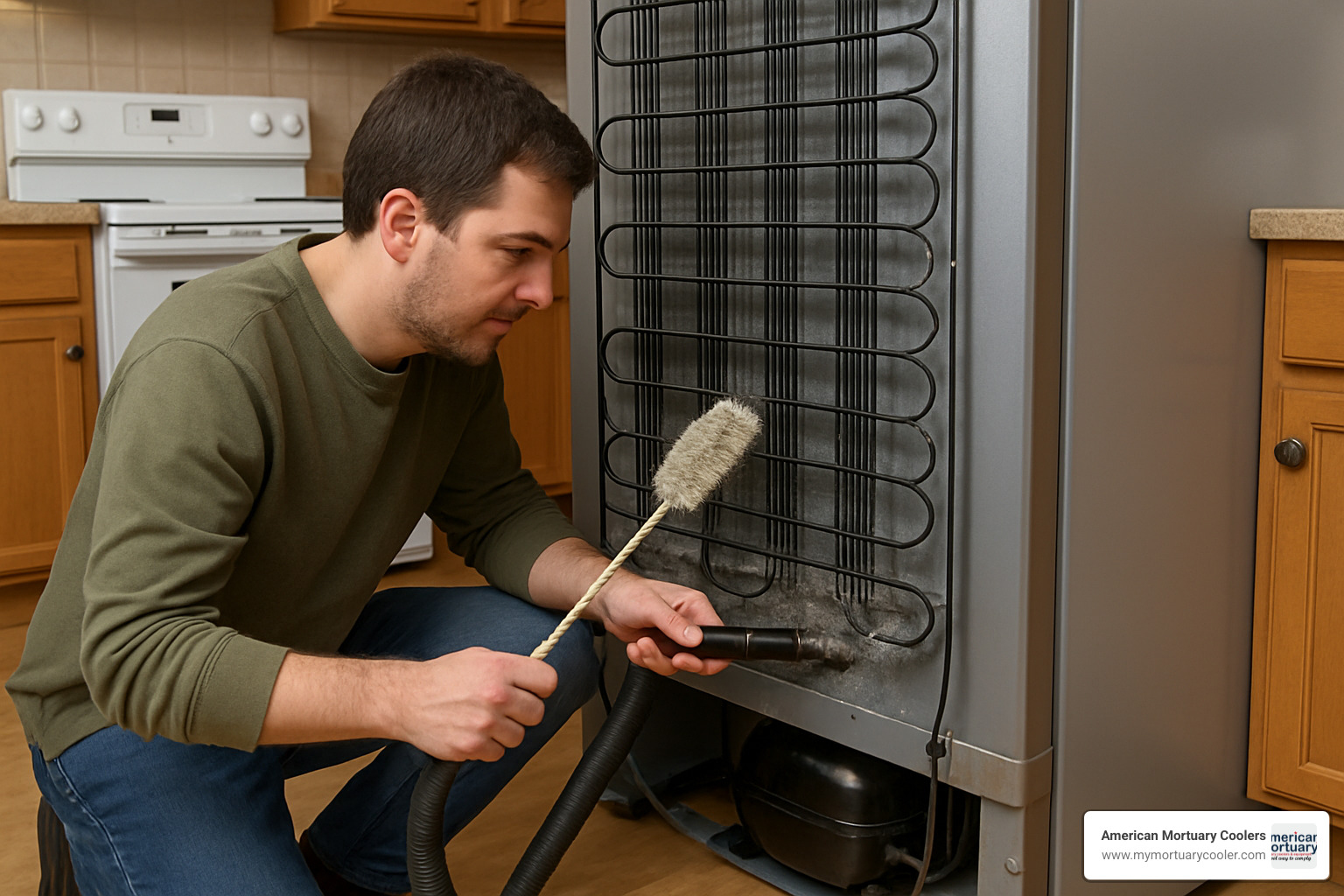
Extending Lifespan & Avoiding Repairs
Proper installation starts longevity - allow inch clearance on all sides for ventilation. Surge protectors provide cheap insurance against electrical damage that can destroy expensive compressors.
Usage habits matter significantly. Keep units about two-thirds full for optimal efficiency. Let hot leftovers cool before refrigerating to avoid stressing the system.
Research shows 33% of refrigerators need repairs by year five, making preventive care your best defense against costly service calls.
Emerging "Smart-Fridge" Features
Internal cameras let you check contents while shopping, proving more useful than expected. Energy monitoring tracks consumption and can shift cooling cycles for cheaper off-peak rates.
Family hub functions turn fridges into command centers with touchscreens, calendars, and voice control. Predictive maintenance represents the most practical feature, alerting you to potential problems before expensive failures.
The trade-off involves increased complexity and cost - more electronics mean more potential failure points. Consider whether convenience justifies premium pricing and additional maintenance requirements.
Frequently Asked Questions about "is a refrigerator"
How long does a refrigerator typically last?
Is a refrigerator built to last? Most refrigerators serve faithfully for about 13 years on average, though this varies by style and care.
Top-freezer models tend to outlast fancier designs due to fewer moving parts. French door units often need repairs sooner due to sophisticated mechanisms.
Proper installation, regular maintenance (especially cleaning condenser coils), and good usage habits can extend life to 15-20 years. Neglected units might fail in just 8-10 years.
What size refrigerator do I need for a family of four?
The standard recommendation is 19-22 cubic feet for a family of four, but lifestyle matters more than headcount.
Cooking style makes a big difference - home cooks storing fresh ingredients need more space than families eating out frequently. Shopping patterns matter too - warehouse store shoppers might need 25-30 cubic feet while frequent fresh shoppers can manage with less.
Remember usable capacity is 10-15% less than manufacturers claim due to shelves and internal components.
How cold should a refrigerator and freezer be set?
Your refrigerator should stay between 0-4°C (32-40°F), with ideal temperature around 2-3°C (35-38°F). This slows bacterial growth without freezing fresh foods.
Freezers need -18°C (0°F) or slightly lower to halt bacterial growth completely and preserve food quality for months.
Don't trust built-in displays alone - use appliance thermometers to check temperatures in different compartment areas. Allow 24 hours after adjustments before rechecking.
Conclusion
Understanding is a refrigerator more than just a cooling box reveals the remarkable engineering behind this everyday essential. From the refrigeration cycle that moves heat against nature's flow to smart features that save money and reduce waste, today's refrigerators pack impressive technology into familiar appliances.
Proper sizing matters - consider actual habits, shopping patterns, and lifestyle needs rather than just buying the biggest unit that fits. Energy efficiency pays off over time through hundreds in savings over a 13-year lifespan.
Regular maintenance extends life significantly. Simple tasks like cleaning coils twice yearly and checking door seals take minimal effort but add years of service.
When choosing styles, function trumps fancy features for most families. Top-freezer models offer reliable performance, while French door units provide organization at higher costs.
At American Mortuary Coolers, we apply these refrigeration principles to create custom cooling solutions for funeral homes and specialized facilities. Whether you need household refrigeration or specialized commercial equipment, the fundamental science stays the same.
The refrigerator's evolution mirrors our growing understanding of physics and energy efficiency. As technology advances, we see smarter features while maintaining that core mission of safe, efficient food preservation.
For specialized cooling needs, American Mortuary Coolers provides durable, custom equipment with direct delivery across the contiguous 48 states. Our Tennessee-based team understands that is a refrigerator question encompasses food safety, energy responsibility, and choosing the right solution for your specific situation.
Understanding these fundamentals helps you make smart decisions that serve you well for years to come.
For more practical guidance, explore our More info about practical guides and find how proper refrigeration supports everything from family meal planning to critical commercial applications.
















